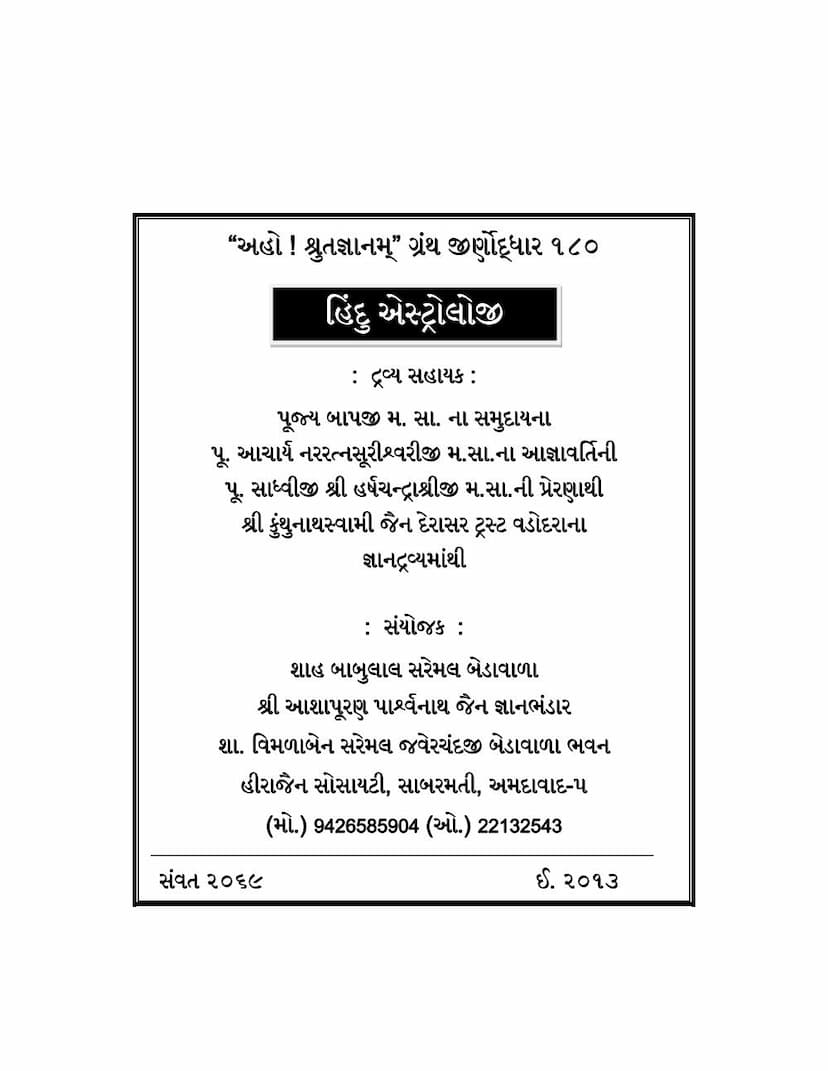Hindu Astrology
Added to library: September 1, 2025

Summary
Here's a comprehensive summary of the Jain text titled "Hindu Astrology" by Pitambardas T. Mehta, based on the provided pages:
The book, "Hindu Astrology," authored by Pitambardas T. Mehta and published by Pitambardas T. Mehta, is a critical examination of traditional Hindu astrological practices. The publication is associated with the "Aho! Shrutgyanam Granth Jirnoddhar" project, aimed at digitizing and preserving ancient Jain texts.
The author's primary objective is to debunk what he perceives as fraudulent and superstitious elements within Hindu astrology, particularly the practice of phaladesh (astrological predictions). Mehta argues that while astrology is based on astronomical knowledge, its popular application has been corrupted by self-serving individuals who exploit people's fears and ignorance.
The book is structured into three main sections:
Chapter 1: What is Astrology?
- Mehta begins by defining astrology as a science rooted in mathematics, geography, and astronomy. He asserts that true astrology provides knowledge about celestial bodies, their distances, movements, and the natural phenomena they influence, such as seasons and tides.
- He traces the origins of astrological thought back to ancient civilizations like India, China, and Egypt, acknowledging the contributions of various scholars and astronomers.
- A significant portion of this chapter focuses on explaining the scientific understanding of the solar system, including the sun, planets (Mercury, Venus, Earth, Mars, Ceres, Pallas, Juno, Jupiter, Saturn, Uranus, Neptune), their properties, and their movements based on contemporary scientific understanding (as of the publication era). He emphasizes the heliocentric model and the laws of physics governing celestial bodies, contrasting it with older, more geocentric beliefs.
- He highlights the role of mathematics and precise instruments in modern astronomical calculations, deeming astrology without this foundation as "useless."
Chapter 2: How Hindus Use Astrology (Phaladesh)
- This chapter delves into the practical application of astrology in Hindu society, specifically focusing on phaladesh (predicting future outcomes).
- Mehta critically analyzes the components of Hindu astrology, such as Panchang (almanac) – including tithi (lunar day), var (day of the week), nakshatra (lunar mansion), yoga (planetary conjunctions), and karan (lunar day subdivisions). He explains their traditional significance and astrological interpretations.
- He dedicates considerable space to dissecting the popular astrological practices:
- Nakshatras: He describes the 27 lunar mansions, their associated deities, characteristics, and supposed astrological effects, arguing that these are merely arbitrary divisions of the sky.
- Yogas: He explains various yogas formed by planetary conjunctions and their predicted outcomes, pointing out inconsistencies and contradictions.
- Muhurta: He examines the practice of selecting auspicious times (muhurta) for various life events (e.g., weddings, naming ceremonies, travel) and critically analyzes the often-contradictory advice given by astrologers.
- Phaladesh (Predictions): He scrutinizes the widely held belief that planetary positions at birth (janma patri or horoscope) and yearly predictions (varshal) determine a person's fate. He also discusses prashna (divinatory astrology based on questions asked).
- Superstitions: He criticizes practices like interpreting omens (shukna), the significance attributed to specific days or times for certain activities, and the belief in auspicious or inauspicious combinations.
- "Phaladesh" Calculations: He explains how panchang is used to make predictions, detailing the methods for calculating tithi, nakshatra, and other elements, often highlighting the arbitrary nature of these calculations and the inconsistencies found among different astrological texts.
- Astrological Houses: He explains the division of the horoscope into 12 houses and their supposed influence on different aspects of life (e.g., self, wealth, siblings, health, marriage, longevity, father, career).
Chapter 3: The Negative Impact of Astrological Predictions
- This is the most critical section of the book. Mehta asserts that the practice of phaladesh has caused immense harm to individuals and society by fostering superstition and dependency.
- He argues that people, misled by astrologers, lose faith in God and rely solely on fate dictated by planets, leading to a sense of helplessness and inaction.
- He cites numerous examples of contradictions and inconsistencies within astrological texts and predictions. He points out how different astrologers offer conflicting interpretations and how predictions often fail to materialize.
- He specifically addresses the common belief that specific planetary configurations at birth determine wealth, health, relationships, and lifespan, calling these claims baseless and exploitative.
- Mehta criticizes the methods used by astrologers, such as claiming divine inspiration or using elaborate rituals and donations for appeasement, which he views as a means of financial exploitation.
- He strongly condemns the practice of dasha (planetary periods) and yog calculations, deeming them mere fabrications used to create fear and extract money from the public.
- He highlights instances where people have suffered financial ruin or emotional distress due to following the advice of astrologers, providing anecdotes about individuals who made disastrous decisions based on astrological predictions.
- He also criticizes the supposed influence of certain nakshatras and yogas as inauspicious, arguing that these are also unfounded beliefs.
- Mehta debunks the concept of planetary "combustions" (asta) and "retrograde motion" (vakra gati) as they relate to astrological outcomes, explaining them as purely astronomical phenomena without inherent predictive power.
- He tackles specific astronomical events like eclipses (grahan), meteor showers (khartara tara), and lightning (vijali), refuting the astrological interpretations and explaining them through scientific principles. He argues that concepts like Rahu and Ketu are merely mathematical points of intersection of orbital planes, not physical entities that can cause harm.
Overall Argument and Conclusion:
Mehta's central thesis is that while the scientific study of astronomy is valuable, the astrological interpretations and predictions prevalent in Hindu tradition are largely based on superstition, fear-mongering, and financial opportunism. He believes these practices lead to ignorance, dependency, and a deviation from rational thinking and self-reliance. He urges readers to question these beliefs, rely on scientific understanding, and focus on personal effort and divine faith rather than the arbitrary influence of celestial bodies. The book is a strong advocacy for critical thinking and a scientific approach to understanding the cosmos, free from the shackles of outdated and exploitative traditions.